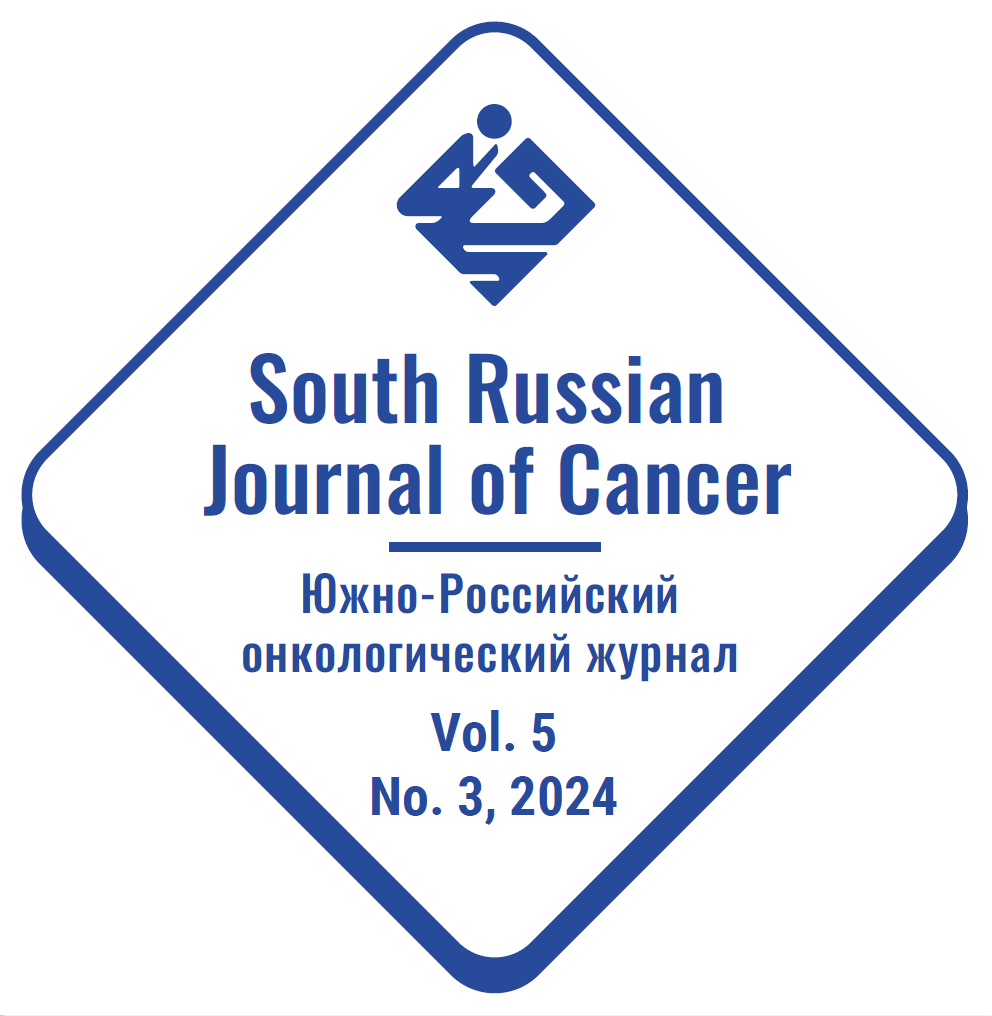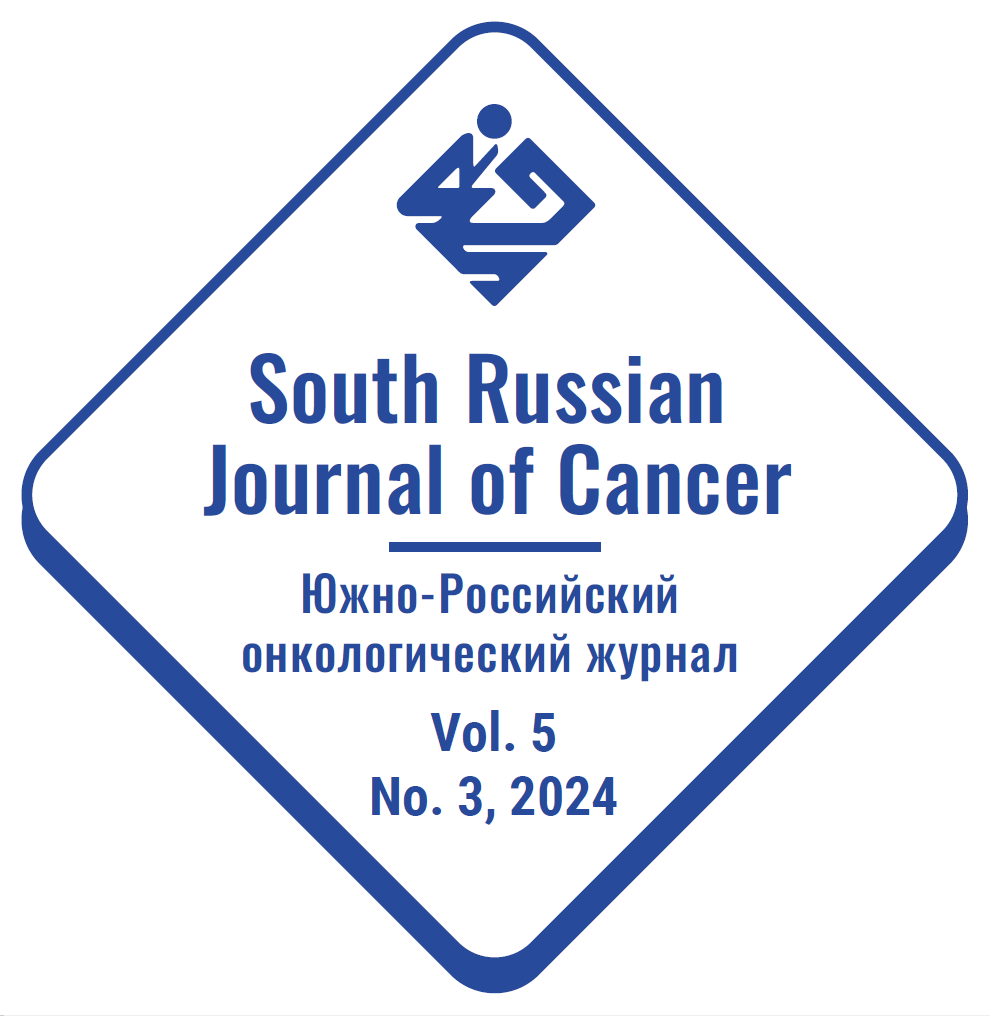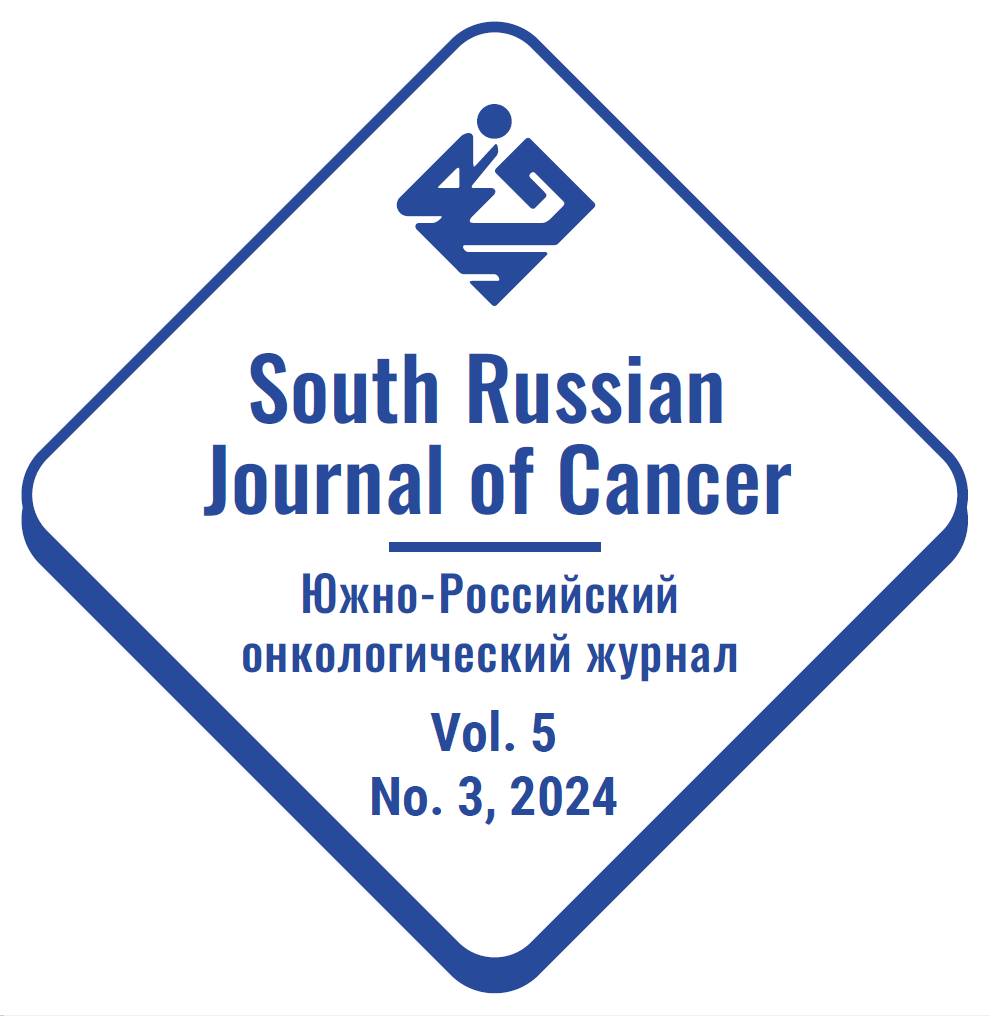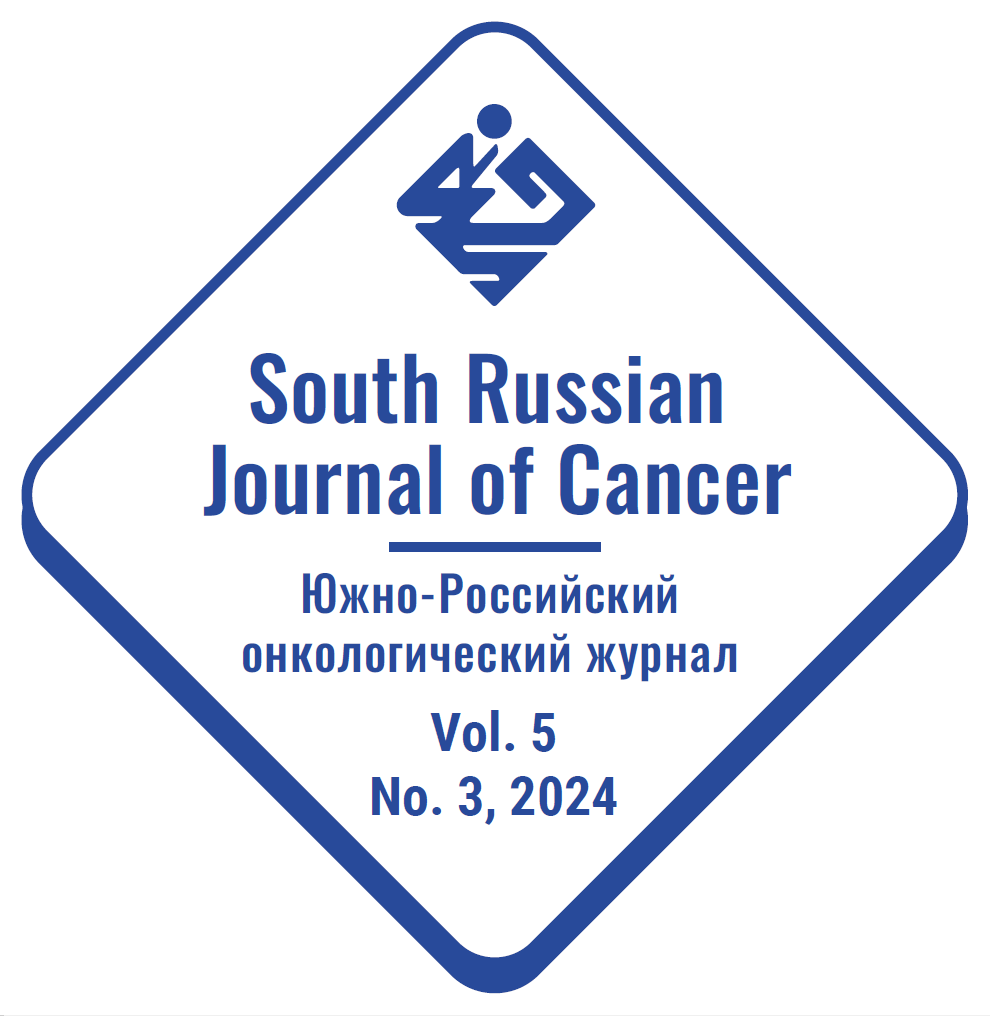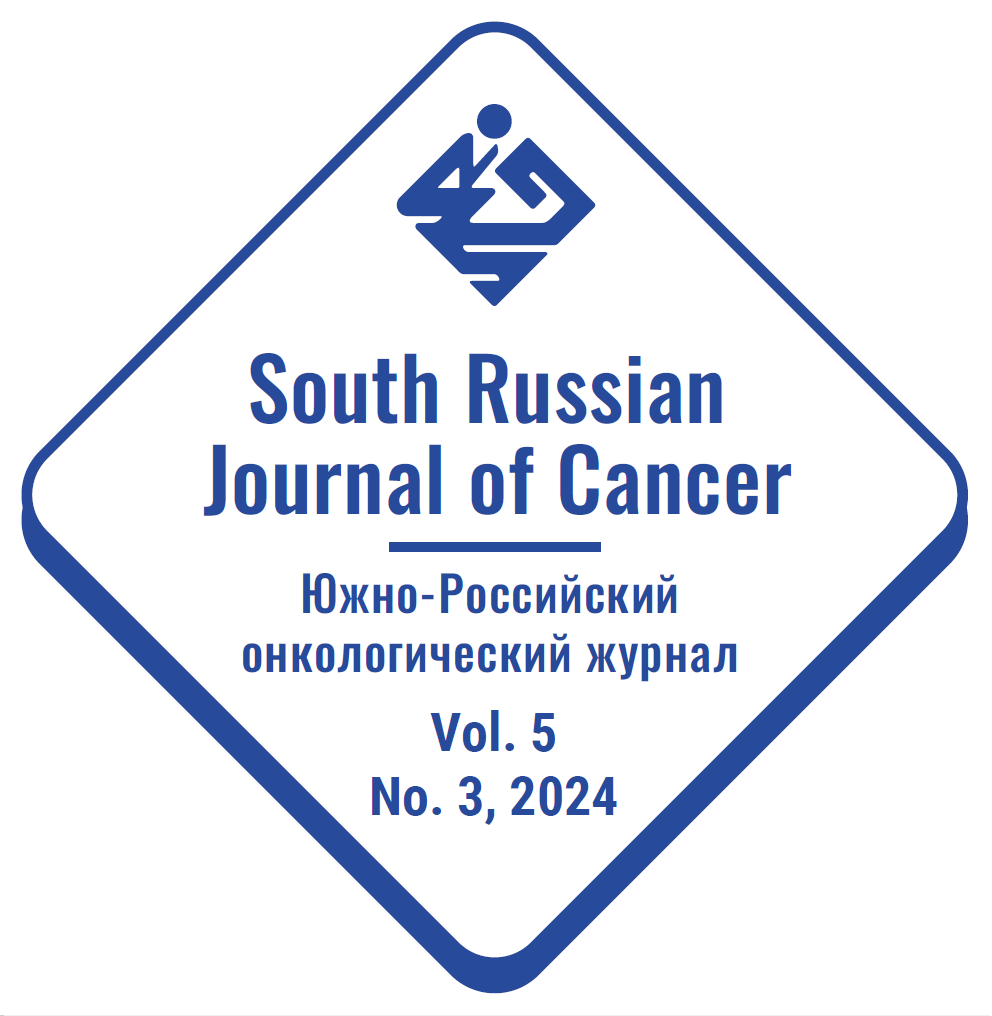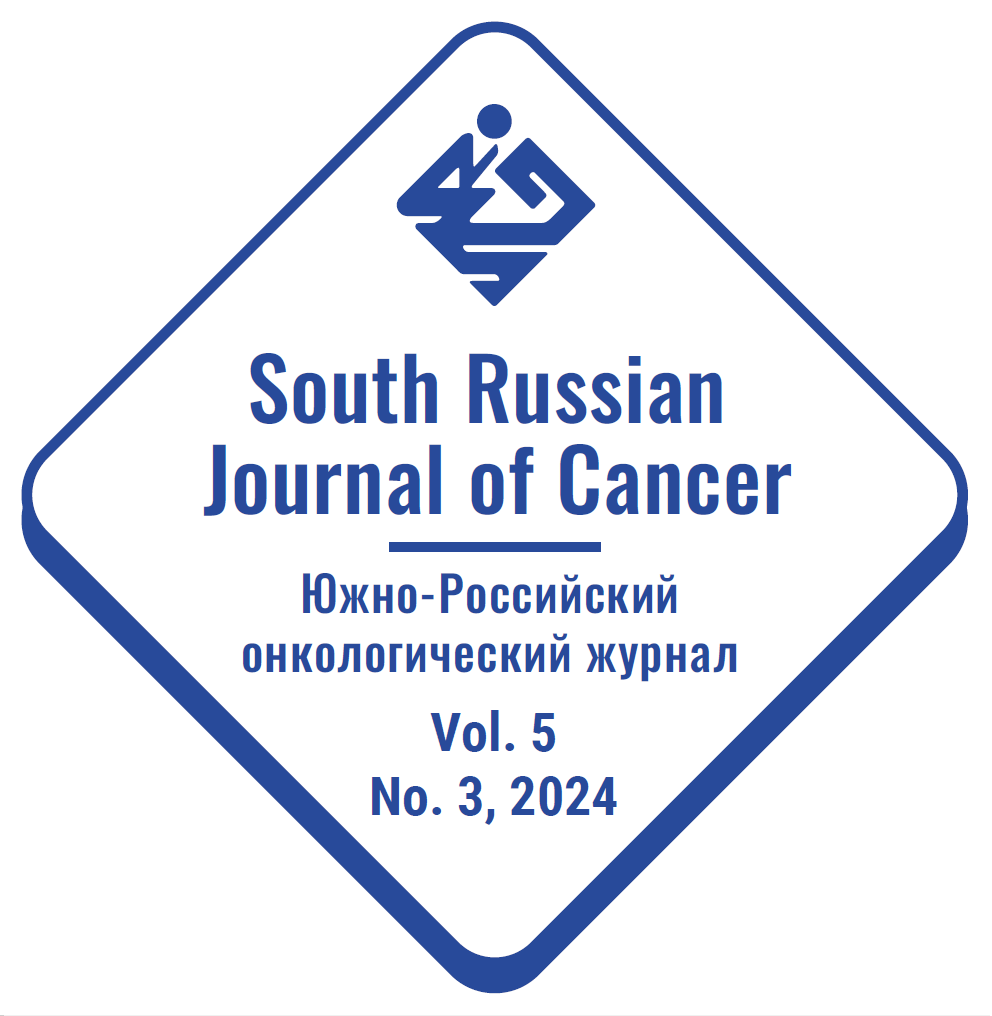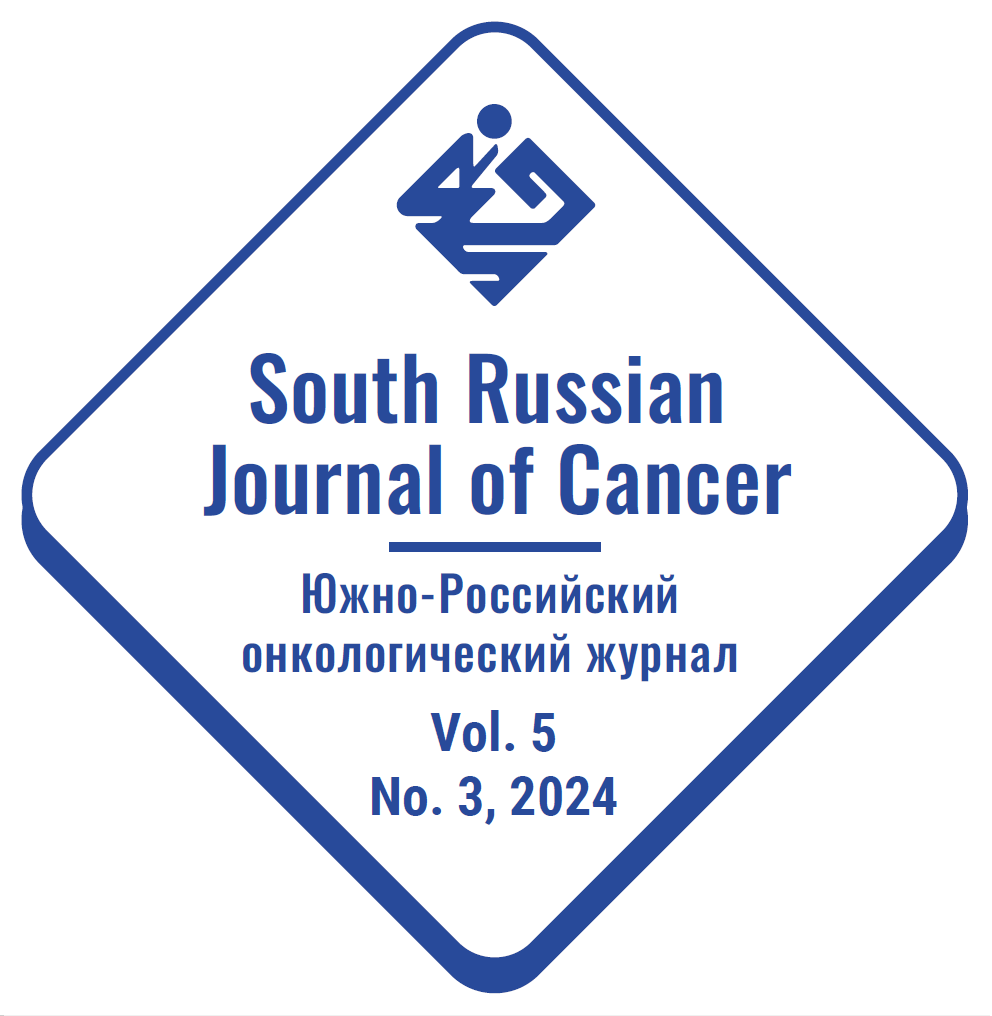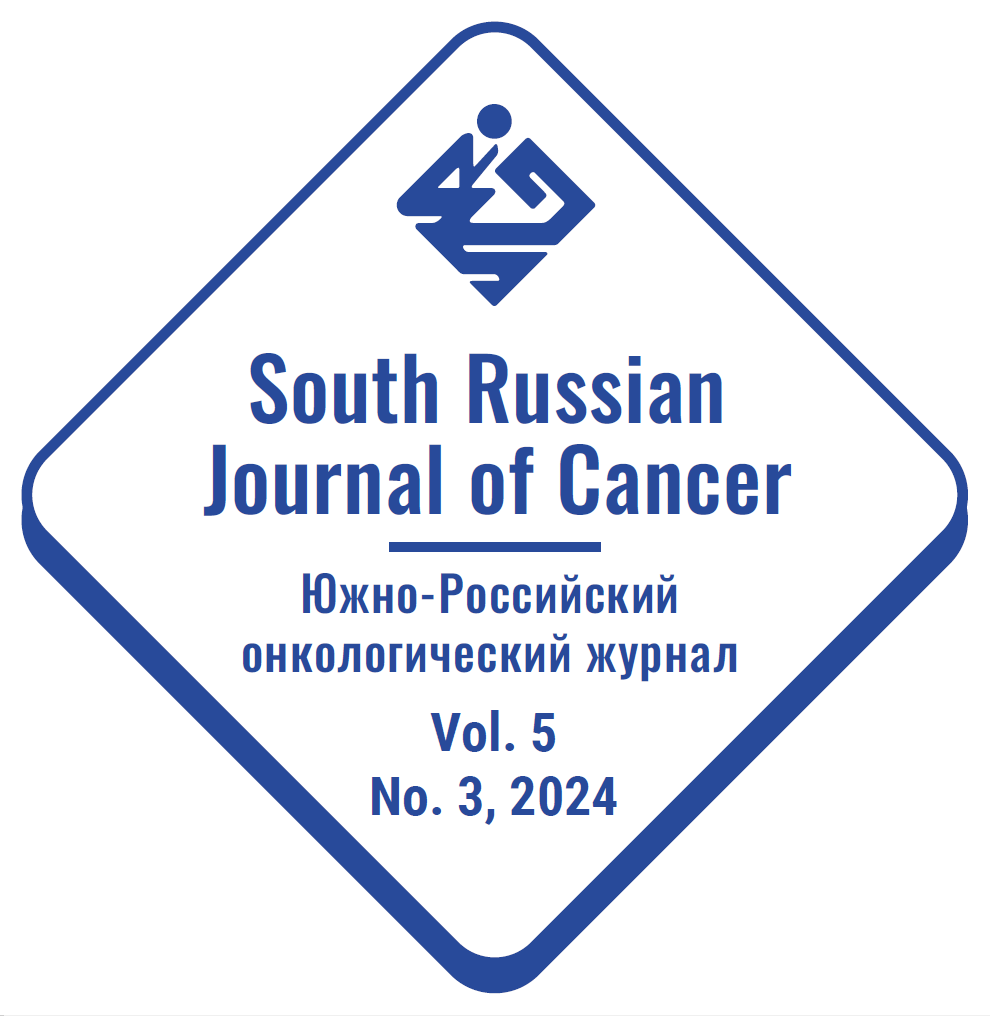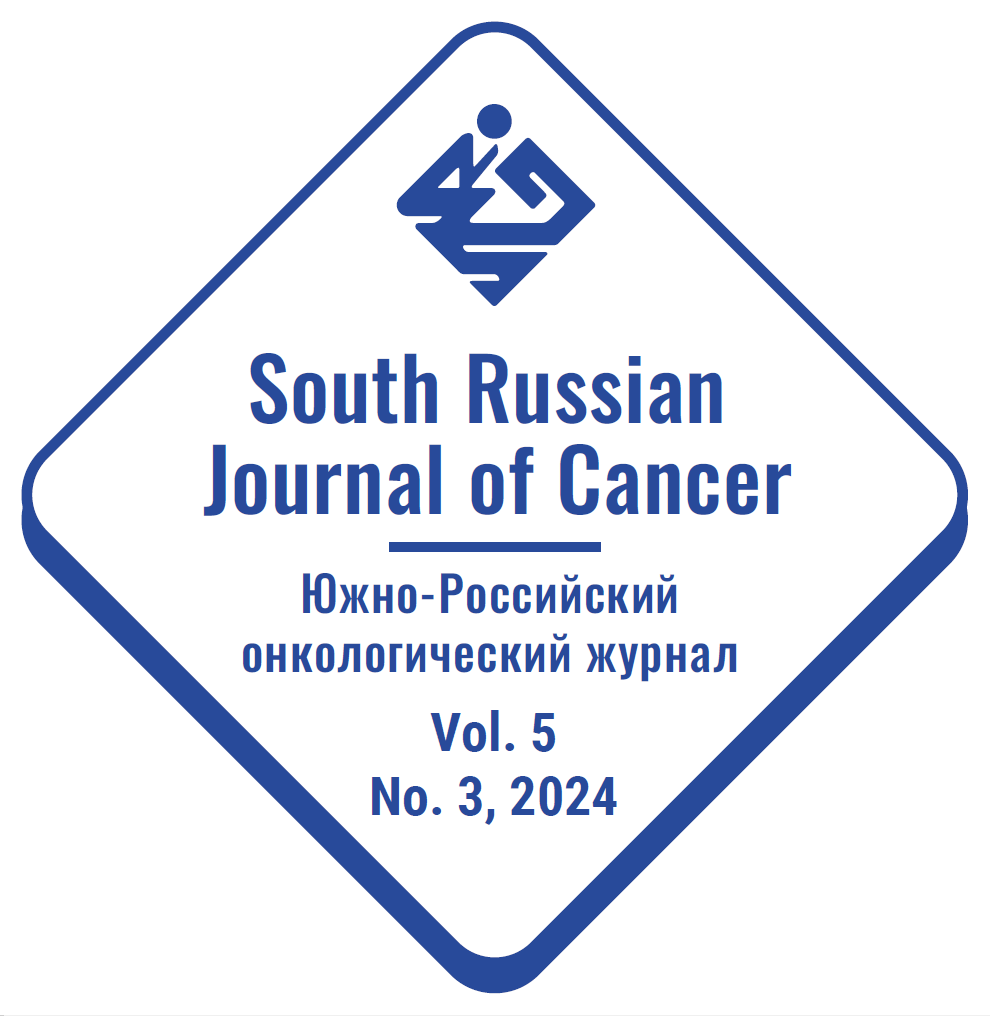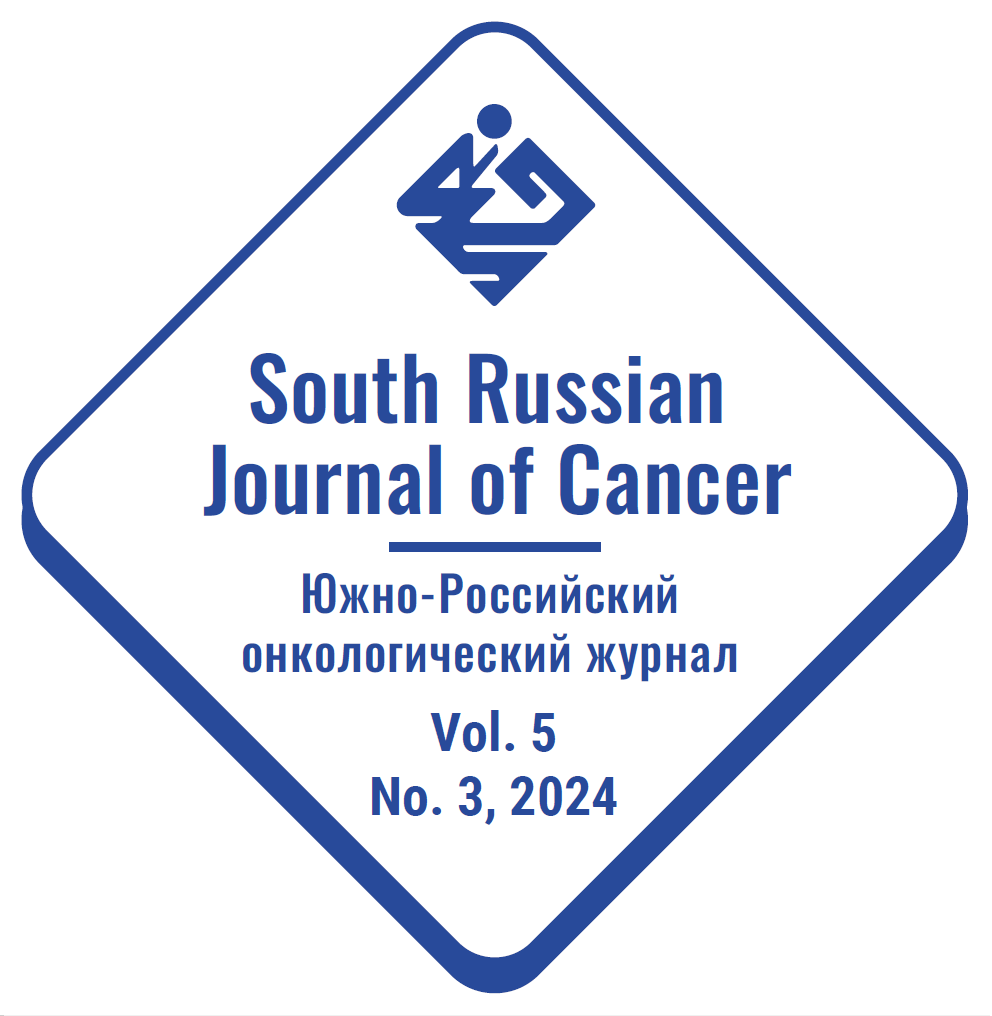ORIGINAL ARTICLES
Purpose of the study. Development of a method for preventing hemorrhages during stereotactic biopsy of a brain tumor using liquid hemostatic matrices on the example of the drug "Floseal®".
Patients and methods. The target of the biopsy is the most representative area of tumor tissue according to the data of various modalities of MRI neuroimaging, including contrast-enhanced ones. Out of 133 patients, 60 patients with signs of intraoperative bleeding along the biopsy needle cannula were included in the study group. Further, patients with signs of intraoperative bleeding along the cannula of the biopsy needle were divided into 2 subgroups by independent sequential randomization. Control subgroup (n = 45): cases with signs of intraoperative bleeding of varying severity were operated on, according to the standard technique, without the use of the liquid hemostatic drug Floseal®. The main subgroup (n = 15): in case of intraoperative signs of bleeding, the hemostatic fluid drug Floseal® was injected into the area of tumor material removal.
Results. In 6.7 % of patients of the control subgroup, the formation of massive intracerebral hemorrhages was noted in the postoperative period. In 53.3 % of the observations of the control subgroup according to X-ray computer examinations of the brain, there were signs of minor hemorrhages at the point of tumor material collection, which did not require repeated surgical interventions. Postoperative hemorrhages after injection of the Floseal® liquid hemostatic matrix into the biopsy needle in the study subgroup were not detected according to neuroimaging X-ray CT.
Conclusion. A method of hemostasis has been developed to prevent hemorrhages using liquid hemostatic matrices. If signs of bleeding from the biopsy needle appeare, the introduction of a hemostatic matrix in the volume of 2 ml helps to manage bleeding intraoperatively, as well as to prevent the occurrence of hemorrhage in the early postoperative period.
Purpose of the study. Was to investigate the possibility of applying the method of spheroid formation in culture for assessment of the endometrial cancer (EC) tumor stem cells (TSC) content in complex samples containing various tumor cells and microenvironment.
Materials and methods. Primary cultures were obtained from fragments of tumors removed during surgery as a first stage of treatment at the Department of Gynecological Oncology, the National Medical Research Center for Oncology. After enzymatic disaggregation of tissue, cell suspension was passaged in DMEM medium containing 10 % fetal bovine serum and 1 % gentamicin to obtain primary two-dimensional cultures. To study the ability of cells to form spheroids, the primary culture was removed from the culture plate and passaged with 2.0 × 104 cells per well of a six-well plate (n = 6) in DMEM medium containing 0.35 % agarose and growth factors EGF (20 ng/ml) and FGF (20 ng/ml). After two weeks of cultivation, the average size, number of formed spheroids, and frequency of spheroid formation were determined. For those cultures that had formed spheroids, immunofluorescent staining of the two-dimensional culture for the marker CD133 was performed, after which the frequency of CD133+ cells was determined.
Results. A total of nine primary cultures of EC were obtained, five of which formed spheroids within two weeks of cultivation under non-adhesive conditions. In these cultures, small polygonal CD133+ cells showed the strongest association with spheroid formation, which were associated with the largest spheroids (98–110 μm in diameter).
Conclusion. There is a large number of microenvironmental cells in mixed cultures of CSC, some of which may express CD133, including healthy stem cells that also form spheroids in soft agar. A more detailed study of CSC subpopulations compared to normal endometrium is required to establish a link between the observed diversity of cells in culture and their ability to form spheroids and other characteristics of tumor stem cells.
Purpose of the study. To determine the influence of prognostic factors on survival rates in patients with metastatic renal cell carcinoma (mRCC) aged ≥ 75 years.
Materials and methods. A retrospective study included 77 mRCC patients aged ≥ 75 years who received systemic therapy at the Municipal Oncologic Hospital No. 62 in Moscow and the Municipal Oncologic Dispensary in St. Petersburg from 2006 to 2019. Clinical data from medical records were obtained and analyzed retrospectively, all patients underwent clinical, laboratory, and pathomorphological examination. Patients' survival rates were evaluated using the statistical method of survival time analysis (Survival Analysis). Descriptive characteristics of survival time were calculated in the form of life tables, and Kaplan-Meier curves were constructed.
Results. In the present study, a favorable prognosis according to International Metastatic Renal Cell Carcinoma Database Consortium (IMDC)was noted in 20.8 % of patients with mRCC aged ≥ 75 years; 6.5 % had solitary metastases. The 3- and 5-year survival rates were 35.8 % and 21.2 %.
In single-factor analysis in mRCC patients ≥ 75 years of age, it was found that ECOG status (p < 0.001), histological subtype (p = 0,01), Fuhrman grade of tumour differentiation (p = 0.003), type of metastases (p = 0.045), liver metastases (p < 0.001), IMDC prognosis (p = 0.042) and nephrectomy (p = 0.014).
Conclusion. In a multivariate analysis, factors affecting survival in patients with mRCC aged ≥ 75 years included sex, histologic subtype, number of metastases, bone and lymph node metastases, IMDC prognosis, and radiation therapy and nephrectomy. Further studies are needed to identify additional personalized prognostic factors in elderly patients with mRCC.
Purpose of the study. To analyze the long-term results from various strategies of endovascular treatment for coronary artery disease (CAD) in patients concomitant with cancer.
Patients and methods. 74 patients with both CAD disease and cancer were treated in A. V. Vishnevskiy National Medical Research Center of Surgery from 01/01/2018 to 12/31/2022. By a multidisciplinary council, patients were divided into three groups: group 1 (n = 39) – staged treatment: percutaneous coronary intervention (PCI) is the first stage, the second is surgical treatment of cancer; group 2 (n = 14) – staged treatment: the first stage was surgical treatment of cancer, and the second stage was PCI; group 3 (n = 21) – PCI and open surgery were performed on the same day.
Results. In the immediate period, 3 (4.0 %) deaths were observed: 2 (5.1 %) in group 1, 1 (4.8 %) in group 3, the cause of which was complications arising after oncological surgical interventions. One (2.6 %) patient from group 1 had acute myocardial infarction (AMI) due to acute stent thrombosis in the left anterior descending artery (LAD). The patient underwent successful emergency PCI. In the long-term period, 15 (25.4 %) patients died, out of which 11 (18.7 %) from progression of cancer, and 4 (6.7 %) from other causes. Among the major cardiovascular complications, the following were observed: 1 (3.2 %) AMI in group 1 and 1 (7.1 %) in group 2.
Conclusion. In the long-term follow-up period, the leading cause of death (73,3 %) was progression of cancer. There were no detected from deaths AMI, which confirms the importance and feasibility of myocardial revascularization in this severe group of patients. PCI in patients with coronary artery disease in combination with cancer allows for effective and safe surgical treatment of malignant pathology without cardiac mortality both in the immediate and long-term follow-up periods.
Purpose of the study. To evaluate the cellular, genomic (gene copy number) and transcriptomic (gene expression) effects of P.hybridus (L.) secondary metabolites when they affect the HeLa cell line.
Materials and methods. The isolation of secondary metabolites from plant material and its identification were carried out by preparative chromatography. The composition was determined using mass spectrometric analysis, and the final verification of structural formulas was carried out by nuclear magnetic resonance at the Department of Natural Compounds, the Faculty of Chemistry of the Southern Federal University. The subsequent phase of the study was conducted using both cultural and molecular methods. HeLa cells were cultivated under standard conditions in a MEM medium. Once the confluence level was reached 75–80 %, the nutrient medium was replaced with the introduction of the studied compounds (at a concentration of 4 micrograms/ml) and cultivated for 72 hours. Cell mortality was determined using a NanoEnTek JuliFl counter (Korea) in the presence of 0.4 % trypan blue. The assessment of apoptosis following secondary metabolite exposure was conducted on a BD FACSCanto II flow cytometer using the FITC Annexin V Apoptosis Detection Kit I. The level of replication and expression of the genes responsible for apoptosis was assessed by digital droplet PCR (ddPCR).
Results. The following compounds were isolated and verified, and were assigned the following sequence numbers to facilitate their use in the experiment: No. 2 – 2,4-dihydroxy-2,5-dimethylfuran-3(2H)-one, No. 3 – 5-(hydroxymethyl) furan-2-carbaldehyde, No. 5.3 – 2,2,8-trimethyldecahydroazulene-5,6-dicarbaldehyde, P. hybridus (L.) At the stage of cell death assessment, it was found that the greatest effect was achieved in the compound under ordinal No. 2. However, the evaluation of the copy number and expression of the CASP8, CASP9, CASP3, BAX, BCL2, TP53, MDM2, CDKN1B, CDK1, CCND1, CCND3, and RB1 genes by DD-PCR revealed the presence of apoptosis initiation in tumor cells at the molecular level under the action of compounds No. 2 and No. 5.3 obtained from P. hybridus (L.).
Conclusion. The outcomes were multifeatured. Only compound 2,4-dihydroxy-2,5-dimethylfuran-3(2H)-one exhibited a pronounced cytostatic effect out of all compounds utilized in the experiment. Concurrently, the compound 2,2,8-trimethyldecahydroazulene-5,6-dicarbaldehyde was found to induce an increase in the expression of the CASP3, CASP8, TP53, and BAX genes.
Purpose of the study. To study the possibility of detecting freely circulating DNA of the H3F3A (K27M) gene in blood plasma and cerebrospinal fluid in the lumbar spine in children with diffuse midline gliomas (DMG) during a course of radiation therapy (RT).
Materials and methods. Molecular genetic studies were carried out by digital PCR. 96 samples of lumbar cerebrospinal fluid and 288 samples of peripheral blood plasma from 96 pediatric patients were analyzed. The concentration of circulating tumor (ctDNA) mutant DNA and wild-type DNA of the H3F3A (K27M) gene was determined in the studied material against the background of a course of RT. Lumbar cerebrospinal fluid sampling was performed once at the beginning of therapy, blood sampling was performed three times: The 1st test before the start of RT, the 2nd against the background of a total dose 10–15 Gy, and the 3rd after the completion of the RT course. Patients are divided into the following groups: patients with stabilization of brain tumor growth during early magnetic resonance (MR) control 3 months after completion of the course of RT; patients with disease progression during the same follow-up period who underwent radiation or chemoradiotherapy.
Results. When the disease stabilized after a RT course during treatment, the concentration level of both the mutant variant of ctDNA and wild-type ctDNA significantly decreased in the third blood fraction. The absence of changes or an increase in the concentration of mutant ctDNA and wild-type ctDNA of the H3F3A (K27M) gene by the end of the course of radiation therapy was typical for patients with disease progression in the form of the appearance of metastatic foci in the central nervous system or continued tumor growth. At the same time, the concentration of wild-type DNA of the H3F3A (K27M) gene in the group of patients with progression was higher both in the lumbar cerebrospinal fluid and in the first fraction of blood plasma.
Connclusion. Determination of the concentration and dynamics of circulating tumor DNA of the mutant and wild-type of the H3F3A (K27M) gene in blood plasma and lumbar cerebrospinal fluid in children with diffuse median gliomas of the brain during radiation therapy is promising from the point of view of predicting the effectiveness of therapy.
Purpose of the study. Bioinformatic search for transcriptomic markers (based on metabolomic data) and their validation in the urine of serous ovarian adenocarcinoma patients.
Materials and methods. The study included 70 patients with serous ovarian adenocarcinoma and 30 conditionally healthy individuals. The search for metabolite regulator genes and gene regulator microRNAs was performed using the Random forest machine learning method. Ribonucleic acid (RNA) was isolated using the RNeasy Plus Universal Kits. The level of microRNA transcripts in urine was determined by real-time PCR. Differences were assessed using the Mann-Whitney test with Bonferroni correction.
Results. Using the Random forest method, metabolite-regulator gene (47 genes) and metabolite-regulator microRNA (613 unique microRNA) relationships were established. The identified microRNAs were validated by real-time PCR. Changes in the levels of microRNA transcripts were detected: miR-382-5p, miR-593-3p, miR-29a-5p, miR-2110, miR-30c-5p, miR-181a-5p, let-7b-5p, miR-27a-3p, miR-370-3p, miR-6529-5p, miR-653-5p, miR-4742-5p, miR-2467-3p, miR-1909-5p, miR-6743-5p, miR-875-3p, miR-19a-3p, miR-208a-5p, miR-330-5p, miR-1207-5p, miR-4668-3p, miR-3193, miR-23a-3p, miR-12132, miR-765, miR-181b-5p, miR-4529-3p, miR-33b-5p, miR-17-5p, miR-6866-3p, miR-4753-5p, miR-103a-3p, miR-423-5p, miR-491-5p, miR-196b-5p, miR-6843-3p, miR-423-5p and miR-3184-5p in the urine of patients compared to conditionally healthy individuals.
Conclusion. Thus, urine transcriptome profiling allowed both to identify potential disease markers and to better understand the molecular mechanisms of changes underlying ovarian cancer development.
Purpose of the study. Investigate the metabolomic profile in tissues of patients with serous ovarian adenocarcinoma.
Materials and methods. The study included 100 patients with serous ovarian adenocarcinoma. Chromatographic separation of metabolites was performed on a Vanquish Flex UHPLC System chromatograph, which was coupled with an Orbitrap Exploris 480 mass spectrometer. Differences were assessed using the Mann-Whitney test with Bonferroni correction.
Results. In ovarian tumor tissue, 20 compounds had abnormal concentrations compared to normal tissue: increased levels of kynurenine, phenylalanylvaline, lysophosphatidylcholine (18:3), lysophosphatidylcholine (18:2), alanylleucine, L-phenylalanine, phosphatidylinositol (34:1), 5-methoxytryptophan, lysophosphatidylcholine (14:0), indoleacrylic acid and decreased levels of myristic acid, decanoylcarnitine, aspartylglycine, malonylcarnitine, 3-methylxanthine, 3-oxododecanoic acid, 2-hydroxymyristic acid, N-acetylproline, L-octanoylcarnitine and capryloylglycine.
Conclusion. A significant metabolic imbalance was found in ovarian tumor tissue, expressed in abnormal concentrations of fatty acids and their derivatives, acylcarnitines, amino acids and their derivatives, phospholipids and nitrogenous base derivatives. The concentrations of these 20 metabolites in tissues can serve as diagnostic markers of ovarian cancer. Thus, metabolomic tissue profiling allowed both to identify potential markers of the disease and to better understand the molecular mechanisms of changes underlying the development of this disease.
REVIEWS
Metastatic lesions account for about 50–60 % of all cases of colorectal cancer (CRC). Currently, the prognosis for metastatic CRC has significantly improved due to the advent of effective drug therapy and the expansion of surgical treatment options. In this regard, the study of modern directions of treatment of metastatic CRC is of particular interest.
In this study, both literature data and obtained treatment results of patients with metastatic colorectal cancer have been analyzed (PubMed, Scopus, eLibrary databases were used) at the National Medical Research Centre for Oncology.
Currently, many factors should be taken into account when planning therapy for patients with metastatic CRC: the characteristics of the tumor itself (biology and localization of the tumor, tumor burden, RAS, BRAF mutational status), the patient (age, performance status, functional state of organs and systems, comorbidity, patient attitude, expectations and preferences) and the treatment itself (toxicity, flexibility of the treatment program, socio-economic factors, quality of life). With a resectable process, surgical treatment with adjuvant or perioperative chemotherapy, and with potentially resectable liver metastases, with massive prevalence, unfavorable prognosis - to carry out the most active drug therapy taking into account the mutational status of the tumor in order to transfer the process to a resectable one. In case of widespread colorectal cancer, drug therapy lines are consistently carried out, the selection of which is based on the goals of therapy, the type and time of primary therapy, the mutation profile of the tumor, and the toxicity of drugs.
Patients with metastatic liver and/or lung lesions should be considered through the prism of surgical treatment, since it is surgical intervention that can significantly improve the results of treatment of patients. Therefore, patients with potentially resectable metastases should receive the most effective treatment and be operated on as soon as the process becomes resectable. At the same time, modern chemotherapy and targeted therapy are an integral part of the treatment of patients with metastatic colorectal cancer.
Malignant gliomas make up 25 % of the central nervous system (CNS) tumors in adults and 8–15 % in children. About half of such gliomas have a median localization and are designated by the term "diffuse midline gliomas" (DMG). DMG in children are typically localized in the area of the pons; in 78 % of such cases a heterozygous somatic mutation H3K27M is present. The prognosis of H3K27M-mutant DSG is very unfavorable, with 2-year overall survival rate being less than 10 %. One of the ways of progression of gliomas leading to the death of patients is the spread of the tumor in the form of metastases. Malignant gliomas metastasize mainly into various structures of the CNS (according to autopsies – in about 20 % of patients with glioblastomas), the probability of their metastases to other organs (so-called extraneural metastases), according to some evaluations, is quite rare and doesn’t exceed 2 %. In our practice since 1993, which counts 1700 children with malignant gliomas, including 830 patients with DMG, we’ve observed only one patient with extraneural metastases. The article describes this case of a child who died of the progression of the DMG’s extraneural metastases, despite the fact that chemoradiotherapy had achieved its stabilization in the CNS. This patient with the initial lesion of the pons and cerebellum had massive metastasis to the lymph nodes: supraclavicular, mediastinal, retroperitoneal and inguinal ones, as well as to both pleural cavities, which occurred about one year after treatment of the progression, which had manifested in the form of continued growth of the primary tumor and its dissemination in the central nervous system. The article provides literature data on the frequency, clinical manifestations and possible treatment approaches for extraneural metastasis of brain gliomas. Extraneural metastases of those tumors occur most often to the bones, lymphatic system, lungs, abdominal organs, soft tissues. The effective treatment for extraneural metastases of gliomas has not been developed yet, which makes it urgent to solve this problem through multicenter studies.



